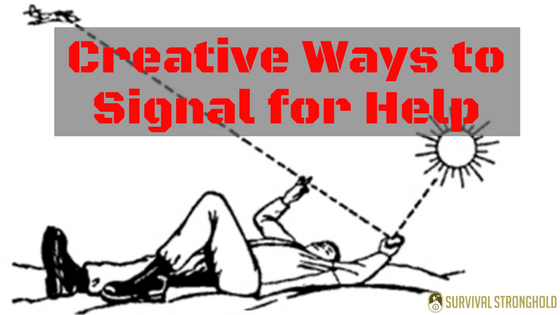If you are stranded in the wilderness or trapped somewhere, your top priority beyond basic survival will be to signal for help. This might be from passing aircraft, boats, or anyone within eyesight who might be able to help; whatever you can do to alert someone else to your location could be life-saving.
Here is a guide to a few different creative ways to signal for help. Keep in mind that you might not always want to signal for help, though, after a large-scale disaster, for example, in some cases, it might be more prudent to lay low and camouflage yourself, but that’s another topic.
These signals are specifically for situations in which you are stranded, and know that if only someone could be made aware of your situation, there’s a good chance it would save you. Let’s begin.
Smoke
You’ve probably heard of Native American smoke signals, well, you don’t have to know a complex code for signaling to use smoke to signify your presence or location to someone who could help.
It might be the light of the fire that catches someone’s attention, but the smoke itself will rise up, in the right weather, and can be seen from many distances. Keep a fire burning as long as you can, constantly if possible, and if you’ve got anything on hand that could cause a very distinct thick, black smoke, use this. If you have any kind of petroleum products to spare, for instance, these will create a great blaze, just be smart and safe about it. You wouldn’t want to add to the trauma of being lost in the wilderness with third degree burns!
Bear in mind that not every location will require the same smoke; in a jungle, for instance, white smoke will do the trick, while in the snow, you’ll want to make sure you can create a very distinctly thick smoke. Also bear in mind the direction of the wind. Days with no wind are more likely to get your smoke noticed, for instance.
Mirrors
Mirrors are a classic apparatus for signaling for help. It is estimated that the signaling range of light reflected off a mirror is up to 100 miles! This beats any other visual signaling device, so definitely keep a mirror with you at all times, if you can.
You can buy mirrors designed specifically for signaling, and you might want to seriously consider this as an investment. It’s an ideal device for EDC, and won’t take up much space. It will have a hole in the middle so you can actually look through and see where your light is hitting, so this makes it incredibly easy to use, and ensures a very precisely aimed signal.
If you are using a different kind of mirror, you’ll have to aim without this handy visual aid, but it’s not too difficult to do. First, face the sun, then hold the mirror as close to your eye as possible. Aim the reflective surface at a distinct object nearby, like a rock or tree. This will give you some idea of the angle you should use to signal off into the distance, sort of like calibrating. Keeping this angle in mind, aim it in the direction of where you expect help to be, such as towards the horizon if you’re stranded on an island looking for ships, towards an airplane you’d like to attract the attention of, etc.
Mylar Blankets
I wrote a whole article about the right way to use mylar blankets, and I did mention that among one of their uses is as a signaling device. They really are great for this, since they’re highly reflective and quite conspicuous. Since they are not solid and flat like a mirror, they won’t work quite the same way, but the basic principle of situating them to reflect the most light will still stand, and, since they tear and fall apart easily anyway, you can use strips of them to mark your location. They’re definitely capable of attracting attention. Since they’re cheap and lightweight, they will definitely make a great addition to any well-stocked bug-out bag without taking up too much room.
Clothing
In many wilderness situations, the clothes on your back will probably stick out. You’ve probably seen an image before of shipwreck survivors frantically waving a flag made out of their own clothing; this is definitely a good way to try to signal help. Anything brightly colored, white, or reflective will work. You can use them to spell out “HELP” or “SOS” on a wide plain, rip them up and make markers on the tops of trees or on a makeshift flag, or simply wave them frantically around when you catch sight of vehicles, aircraft, or other people in the distance.
Rock mounds or messages
In the right terrain, making a tower of rocks or an “SOS” or “HELP” message in the ground with rocks can be incredibly effective. Just make sure it is distinct and conspicious; in an open plain is where you really want to do this. Making something that looks clearly man-made is what will catch the eye of passing people or vehicles.
Sticks
Simple but effective, sticks will always work to spell out a message in a pinch. People have been rescued after passing ships or airplanes saw messages spelled out with sticks, so don’t ever forget how simple it is to make a signal this way!
If you use one of or even all these methods to signal for help, you’ll definitely be doing yourself a favor. Anything you can do to attract the attention of a passing vehicle or human can save your life, so just make sure to get creative and make as many indicators that you are in distress as you can!
Crucial Insider Info on Our National Security…
All Your Gear Won’t Protect You From This…
Have You Considered Going Paleo? Read This First…


